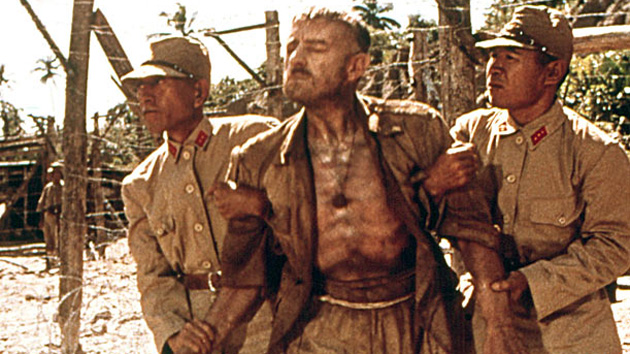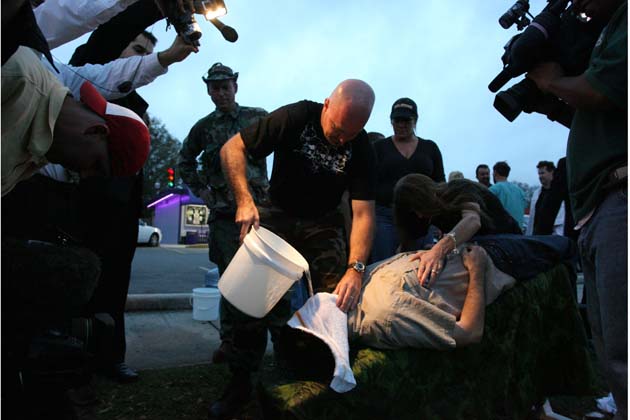
Alec Guinness in "Bridge on the River Kwai."
This story first appeared on the TomDispatch website.
What a way to celebrate Torture Awareness Month!
According to an Amnesty International Poll released in May, 45% of Americans believe that torture is “sometimes necessary and acceptable” in order to “gain information that may protect the public.” Twenty-nine percent of Britons “strongly or somewhat agreed” that torture was justified when asked the same question.
For someone like me, who has been haunted by the daily existence of torture since the September 11, 1973 coup that overthrew Chilean President Salvador Allende, such percentages couldn’t be more depressing, but perhaps not that surprising. I now live, after all, in the America where Dick Cheney, instead of being indicted as a war criminal, sneeringly (and falsely) claims to anyone who asks him—and he is trotted out over and over again as the resident expert on the subject—that “enhanced interrogations” have been and still are absolutely necessary to keep Americans safe.
As for those Americans and Britons—and so many others around the world—who find such horrors justifiable, I wonder if they have ever met a victim of torture? Or do they think this endless pain is only inflicted on remote and dangerous people caught up in unfathomable wars and savage conflicts? If so, they should think again.
When I read these sorts of statistics a scene comes back to me. I remember a man I met 20 years ago, not in my native Latin America or in faraway lands where torture is endemic, but in the extremely English town of Berwick-upon-Tweed.
Everybody in the room that day was crying, except for the man who had moved us all to tears, the former prisoner of war whom my son Rodrigo and I had traveled thousands of miles to meet. We had hoped to do justice to his story in a biopic, Prisoners in Time, that the BBC wanted to make for television—based on the same autobiographical material used recently in The Railway Man, the film starring Colin Firth and Nicole Kidman now showing in theaters across America.
And what an extraordinary story it was!
Eric Lomax, a British officer in World War II, had been tortured by the Japanese in Thailand while working on the infamous Bangkok-Burma railroad, the one most people know about through another film, The Bridge on the River Kwai. Eric, like so many victims of atrocities, was plagued by the experience, his life destroyed by memories of his agony and the desire for revenge. What differentiated him from so many others persecuted worldwide was not only that, more than 40 years later, he tracked down the man he held responsible for his suffering, the anonymous interpreter at his beatings and waterboardings, but the astounding fact that this tormentor, Takashi Nagase, once found and identified, turned out to be a Buddhist monk. Nagase had spent the postwar decades denouncing his own countrymen for their crimes and trying to atone for his role in the atrocities he had helped commit by caring for innumerable orphans of the Asians who had died building that railroad. The one scorching image from the war he could not escape was that of a brave young British lieutenant over whose torture he had presided and whom he had presumed to be dead.
 Once Eric Lomax resurfaced, once the two former enemies, now old men accompanied by their second wives, met in Kanchanaburi next to the River Kwai where they had last parted, once they were face to face, Nagase begged for forgiveness. It was not instantly forthcoming. But some weeks later, in Hiroshima of all places, Lomax offered Nagase the absolution that he needed in order to live and die in peace.
Once Eric Lomax resurfaced, once the two former enemies, now old men accompanied by their second wives, met in Kanchanaburi next to the River Kwai where they had last parted, once they were face to face, Nagase begged for forgiveness. It was not instantly forthcoming. But some weeks later, in Hiroshima of all places, Lomax offered Nagase the absolution that he needed in order to live and die in peace.
The BBC had chosen me to tell this tale because, in my play Death and the Maiden, I had already probed the issues of torture, memory, mercy, and vengeance from the perspective of my beleaguered country, Chile. But in that play there had been no pardon offered and no pardon sought, so writing about Lomax’s dilemma seemed a way of furthering that original exploration with a series of new questions. Is reconciliation ever really possible when the wounds are searing and permanent? Does anything change if the victimizer claims to have repented? How can we ever know if those claims are legitimate, if that remorse is not merely an ego-trip, an accommodation for the sake of outward appearances?
There was also an aesthetic challenge: given the extreme reserve of both antagonists, their inability to articulate to one another—no less anybody else—what they had been feeling all those years, how to imagine, for the screen, dialogue our two silent former enemies would never have said but that would remain true to their affliction? How to bring their story to people who can’t possibly imagine what torture does to the ones who suffer it and those who create that suffering?
Our visit with Eric and his wife Patti at their home in the far north of England was a way of trying to coax from that emotionally repressed man some information—entirely absent from the memoir he had written—about how he had dealt with the barren wilderness of his sorrow, what it meant to survive torture and war more dead than alive. We were accompanied by director Stephen Walker and celebrated psychiatrist Helen Bamberg, who had helped Eric name his demons, and so saved him and his troubled marriage.
That day in Berwick-upon-Tweed, Eric confided to us, after several hours of halting monosyllables, a painful, unbelievable story. When he returned to England by ship after those traumatic years as a prisoner of war, he discovered just before disembarking that the British Army had deducted from his back pay the cost of the boots he had lost during his captivity. Bamberg, who had managed to get Eric to speak out after many distressing sessions, asked him if he had told anyone about this at the time.
“Nobody,” Eric said. And then, after a pause that felt infinite, “There was nobody there, at the dock.” He stopped and again long minutes of silence went by before he added, “Only a letter from my father. Saying he had remarried, as my mother had died three years before.” Another long pause followed. “She died thinking I was also dead. I had been writing to her all that time and she was dead.”
That’s when we all started to cry.
Not just out of sympathy for his grief, but because Eric had delivered this story about his loss in a monotone devoid of any apparent sentiment, as if all that despair belonged to someone else. Such dissociation is typical of torture victims. Their mental survival during their ordeal and its unending aftermath depends on distancing themselves from the body and its fate. And it is in that distance that they dwell.
We were crying, I believe, for humanity. We were crying in the Lomax living room because we were being confronted with a reality and a realization that most people would rather avoid: when grievous harm has been done to someone, the damage may be beyond repair. Eric Lomax had been able to tame the hatred raging in his heart and, reaching into the deepest wells of compassion, he had forgiven one of the men who had destroyed him. And yet there was still something irreparable, a terror that ultimately could not be assuaged.
The film we wrote two decades ago tried to be faithful to that desolate moment of revelation and at the same time not betray the inner peace that Eric had attained, the fact that he no longer heard Nagase’s voice in his nightmares demanding, “Confess, Lomax, confess and pain will stop.” He had triumphed over fear and fury, but that spiritual victory had not been achieved in solitude. In addition to the support of his wife Patti, it was due to the healing process he had gone through with Helen Bamberg. Not until he had fully come to terms with what had been done to him, until he faced his trauma in all its horror, was he able to “find” Nagase, whose identity and location had, in fact, been within reach for decades.
Eric’s tragedy and his attempt at reconciliation had a special meaning for me: it connected his life to that of so many friends in Chile and other countries who had been subjected to inhuman interrogations. It was a way of understanding the common humanity of all torture victims. More so, as the method that Bamberg employed to resurrect Eric’s memories and restore his mental health had first been elaborated as a therapeutic response to the flood of damaged Latin Americans exiled in England during the 1970s and 1980s, those years when grim dictatorships dominated that continent. Eric Lomax, she said, had the sad privilege of being the first World War II veteran with PTSD who was able to take advantage of this new psychological treatment.
We could not know, of course, that 9/11 awaited us seven years in the future, that the waterboarding inflicted on Eric in the 1940s by the Japanese, and on the bodies of so many Latin Americans decades later by their own countrymen, would go global as the United States and its allies fought the “war on terror.” Nor could we have guessed or would we have dreamed that so many millions would in that future prove so indifferent to a form of punishment that has been classified as a crime against humanity and is against international treaty and law signed onto by most of the world’s nations.
It would seem, then, that Eric Lomax’s story is more relevant today than ever—a story that, one would hope, brings home again, during Torture Awareness Month, the ultimate reality and anguish of being tortured. Or can we accept that the questions Eric Lomax asked himself about forgiveness and revenge, about redemption and memory, no longer trouble contemporary humanity?
How would our friend Eric, who died in 2012, react to the news that so many Americans and so many of the very countrymen he served in the war now declare torture to be tolerable? Perhaps he would whisper to them the words he wrote to Nagase when he forgave his enemy: “Sometime the hatred has to stop.”
Ariel Dorfman, Chilean-American writer and TomDispatch regular, is the co-author, with his son Rodrigo, of Prisoners in Time, which won the 1995 Writers’ Guild of Great Britain Award for Best Feature Film on TV. The film was seen in many countries, with one notable exception: the United States. Dorfman teaches at Duke University and lives with his wife, Angélica, in Durham, North Carolina, and, from time to time, in their native Chile. His latest book is the memoir Feeding on Dreams: Confessions of an Unrepentant Exile. To stay on top of important articles like these, sign up to receive the latest updates from TomDispatch.com here.














